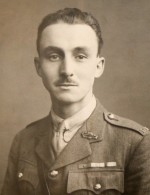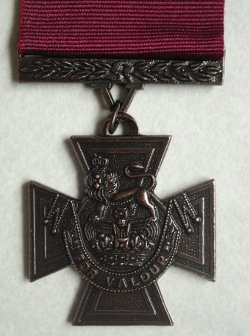Topic: The RCR

Sergeant-at-Arms Gallant Record
The Montreal Gazette, 1 March 1934
He brings to his new duties a genuine wish to fill the post of sergeant-at-arms in a manner wholly in keeping with the finest traditions of the public service. There is no doubt, too, that his appointment meets with the acclaim of all his comrades of the Great War who realize that his selection is a tribute to the entire Canadian corps, living and dead.
Captain William Q. Ketchum writes, in the Calgary Daily Herald of the gallant record of Major M.F. Gregg, V.C.
An important symbol of British parliamentary tradition, the post of sergeant-at-arms of the Canadian House of Commons, calls for unusual qualities, he says.
These particular qualities are possessed to a marked degree by Major Milton Fowler Gregg, V.C., M.C. and Bar, who has been selected from a host of applicants including a number of officers of senior rank. A remarkable feature of the appointment is that Major Gregg, until a recent meeting with Mr. Bennett in Ottawa, was personally unknown to him and, in fact, it is understood, had not even applied for the position.
The new sergeant-at-arms, who succeeds Col. H.J. Coghill, is president of the Vimy Branch of the Canadian Legion in Halifax. Among returned soldiers from coast to coast the appointment is construed, and perhaps rightly so, as an indication that Canada continues to regard the best of her citizenry soldiery as worthy of the highest in her gift to confer.
Of United Empire Loyalist Descent
Major Gregg, who is 41 years of age, was born in Mountain Dale, New Brunswick, the son of George L. Gregg, a prosperous farmer. Through his mother, Elizabeth Myles, Major Gregg is the descendant of United Empire Loyalists, who came from the Thirteen Colonies to Parr Town, now Saint John, New Brunswick, with the "Spring Fleet," in 1783.
He was educated at the Provincial Normal School, Fredericton, and was graduated from Acadia with the degree of M.A. For a time he taught school in Carleton County, New Brunswick.
At the age of 20 he enlisted with the 13th Battalion, Royal Highlanders of Canada, and is still partial to the kilt by reason of this association. Wearing the famous Black Watch tartan he was wounded at Festubert in 1915 and was convalesced at Edmonton, a hospital in the suburbs of London. Obviously Major Gregg had qualities which singled him out for early promotion even in the picked Montreal battalion, and it occasioned no surprise to his friends when he was recommended for a commission before he became a casualty.
After recovering from the effects of his wound he qualified for the rank of lieutenant at the officers' training course at Cambridge, and was gazetted to that rank in the territorials of the Imperial Army, with the King's Own Lancasters. He remained for two months only with this unit and on the eve of going to France was sent to Canadian headquarters in Argyle House. At this time it was decided to divide the Canadian territorially and as a Maritimer, Major Gregg was sent to the Nova Scotia Regiment at Bramshott, and afterwards transferred to The Royal Canadian Regiment, remaining with this infantry battalion until the end of the war.
He was wounded three times, in 1915, 1917, and 1918.
Major Gregg won his first decoration, the Military Cross, after leading a successful night trench raid at Vimy, June 9, 1917. The Canadian had introduced the practice of making raids on enemy sectors to secure prisoners and documents to ascertain the disposition of enemy troops, and to identify units. Following a three-minute artillery barrage, Lieut. Gregg and a handful of resolute companions went through the wire into the shell-pocked No Man's Land until the German front line was reached. This was cleared out and the second line penetrated where a number of prisoners were captured in a deep dug-out. The raid was highly successful and the intrepid young New Brunswick officers received the white-bordered blue-centred Military Cross. He gained the bar to this distinction at Monchy during the Arras show and the Victoria Cross at Cambrai.

Winning the Victoria Cross
 Few winners of the Victoria Cross survive the sacrifice of their heroism. Major Gregg, however, has done so and his friends and official records have supplied the details.
Few winners of the Victoria Cross survive the sacrifice of their heroism. Major Gregg, however, has done so and his friends and official records have supplied the details.
Many Canadian soldiers will remember the Hindenburg Line with its deep dugouts. It was in the Marcoing Line, a section of this system with its deep tunnels, and strong points hitherto considered impregnable that he won the coveted bronze decoration for valor instituted by Queen Victoria in 1856.
Lieut.-Col. C.R.E. Willets, D.S.O., officer commanding The Royal Canadian Regiment, was wounded, the adjutant was killed and the gallant regiment, suffering numerous casualties found its advance obstructed by a heavily defended position. Nothing was visible but bands of uncut wire.
Lieut. Gregg saw no possibility of going forward, but after a quick survey discovered an opening in the wire to the left. Through this gap he crawled on hands and knees, revolver in hand and pockets bulging with Mills bombs. He reached the German line, landed in a shallow trench which he followed to a strong point from which a German machine gun crew of three were pouring murderous fire into khaki-clad Canadians held up by the wire. The R.C.R. officer killed one German with his revolver, wounded the other and the argument of his business-like weapon proved too overwhelming for the third, who surrendered. He advanced to a second menacing strong point where the sight of a Mills bomb with the pin out induced fifteen Germans at the entrance to a deep dugout to throw up their hands.
Their morale restored somewhat when they saw themselves opposed by only one lone figure, the Germans, not knowing how to reach the Canadian lines, wandered off toward a nearby strong point, but Gregg seized a German rifle, picked one or two off and the others capitulated.
In the meantime, inspired by Gregg's gallant conduct, several members of the regiment had followed in his footsteps, so that the position was consolidated.
 On that fateful day Lieut.-Col. C.B. Topp, D.S.O., took over The Royal Canadian Regiment for a short time and his personal knowledge of the resourcefulness, courage and initiative shown by Major Gregg, coupled with five other recommendations, won for the young officer the Victoria Cross.
On that fateful day Lieut.-Col. C.B. Topp, D.S.O., took over The Royal Canadian Regiment for a short time and his personal knowledge of the resourcefulness, courage and initiative shown by Major Gregg, coupled with five other recommendations, won for the young officer the Victoria Cross.
Major Gregg, who is the exemplification of modesty, expresses scepticism over statements that there are men who are never frightened when confronted by the bright eyes of danger, he thinks that what has buoyed up good soldiers in tight situations in the old British tradition of conveying the impression that fear is an alien quality in their make-up. In other words, the theory is to make the other chap feel you are not frightened to stiffen him up. There is a pardonable vanity behind it all, too, in his opinion.
Major Gregg returned to Canada as adjutant of The Royal Canadian Regiment and for a time he held the rank of captain in the Governor-General's Foot Guards.
He has been connected with the New Brunswick Rangers and is brigade major of the 16th Infantry Brigade. His military qualifications are of a high order and include a pass in the militia staff course. He was among the Canadian winners of the Victoria Cross who attended the last reunion in London, England, at which the Prince of Wales took a leading part.
A pre-war romance which had its inception in old Acadia days culminated following the conflict when he parried an old classmate, Miss Amy Dorothy Alward.
He brings to his new duties a genuine wish to fill the post of sergeant-at-arms in a manner wholly in keeping with the finest traditions of the public service. There is no doubt, too, that his appointment meets with the acclaim of all his comrades of the Great War who realize that his selection is a tribute to the entire Canadian corps, living and dead.

